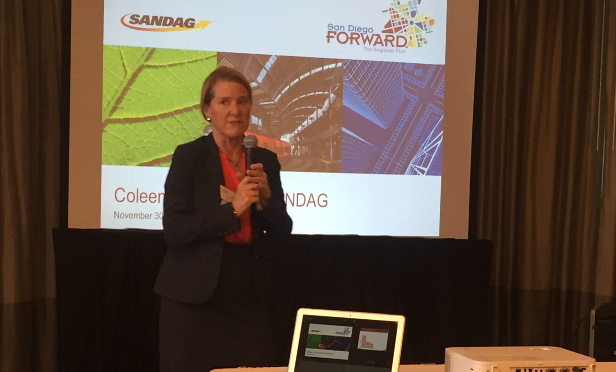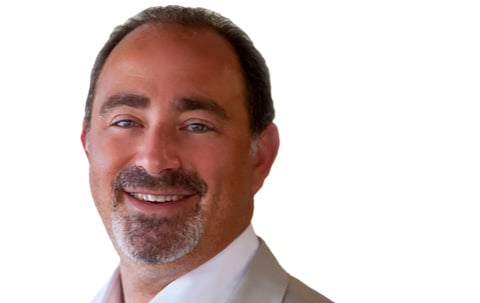
SAN DIEGO—With a projected population growth in this region of 30% by the year 2050, reducing congestion on our streets and solving parking issues are paramount and vital to CRE health, said speakers at CREW San Diego's lunch event Wednesday. The event, titled “Daily Challenges in Commercial Real Estate—Traffic, Parking and Transportation,” presented concerns about these issues, discussed what is being done to alleviate them and offered solutions on how to manage them in the future.
Moderator Rebecca Bodemann, senior sales engineer for Xpedient Communications, defined the issues and introduced panelists Colleen Clementson, principal regional planner of the San Diego Association of Governments; Daniel Reeves, SVP, economic development and public policy for the Downtown San Diego Partnership; and Dr. Bruce Appleyard, assistant professor of city planning and urban design for San Diego State University. Each panelist gave an independent presentation, followed by questions from Bodemann and attendees.
Clementson said housing growth in San Diego is concentrated in the western third of the region, and SANDAG is working to provide more transportation options that are alternatives to driving in order to alleviate road congestion in this area. Several measures are planned between now and 2050, including the trolley expansion, more rapid-bus transportation, double-tracking existing rail lines, more managed freeway lanes and opportunities for more biking and walking choices. The organization is also thinking about creating mobility hubs around communities that provide mass transit and partnering with private-sector companies such as Uber and Lyft to provide better transportation solutions.
Projects currently underway by SANDAG include adding HOV lanes on the I-5 freeway between Solana Beach and Carlsbad, better Coaster service and improvements to bridges and bike lanes, Clementson said. In addition, the Mid-Coast trolley will be offering new stops at UTC, the veterans' hospital in La Jolla and the UCSD campus so that “the trip from the Mexican/US border to UCSD will be much more manageable.” Approximately $1 billion from sales taxes has been raised toward this goal, with a project total estimated to be $2 billion.
Next, Reeves gave a presentation about Downtown San Diego traffic and parking issues and what is being done to alleviate those. He said for the first time in 100 years, urban growth is outpacing suburban nationwide, and driver's license applications are decreasing dramatically among young people. By 2050, 50% of San Diego's workforce will be part of the Millennial demographic, and the question is, “How will we manage business with this changing demographic?”
Getting around Downtown San Diego has been an issue, so the DTSP has been involved in the development and promotion of the FRED (Free Rides Everywhere Downtown) golf-cart-vehicle program, which provides free, on-demand rides from point to point, accessed via smartphone. Currently government subsidized, the program will eventually be sustained by advertising, Reeves said. A high percentage of driving traffic Downtown is people looking for parking, so the FRED program is aiming to deploy 20 vehicles for 5,000 rides per week by the end of the year, and ridership has been increasing from month to month.
Another program recently adopted by Downtown San Diego has been the Downtown San Diego Complete Streets Mobility Plan, which identified all corridors as primarily vehicle, pedestrian, bike or transit priority. A surprising number of Downtown residents walk to work, Reeves said, yet residents and businesses there are still very protective of their on-street parking. The problem was how to convince them that eliminating parking won't hurt them or their business.
Different solutions have been proposed for different areas of Downtown. One solution was to widen parking lanes and eliminate one lane of travel in regions where parking was of prime importance. In areas identified as primarily pedestrian, sidewalk widths could be increased and landscaping added. This solution was ultimately approved.
Additional changes to come Downtown, according to Reeves, address the new generation of users who don't want a long commute to work. More ride-sharing services such as Uber Pool and Lyft Line are being explored, and while “car on demand” service Car2Go is leaving San Diego, bike-sharing service DecoBike is stepping in, along with FRED and traditional transit, to take up the slack. Other possible opportunities to be explored that could alleviate traffic and parking issues include ta Downtown comprehensive parking plan that includes shared and in-lieu parking fees, robotic parking garages, non-traditional transit such as gondolas and water taxis, self-driving cars and drones.
Next, Appleyard spoke to the future of smart connected cities and the need to do a better job of land-use planning. He said travel is a derived demand resulting from how we plan land use, so looking at our strengths and weaknesses in those areas will help develop better policies to alleviate traffic, transportation and parking issues.
Appleyard said studies of higher-accessibilities areas—noted by high walkability, density and proximity to amenities and transportation options—show that they have higher transit use, shorter commutes, a decreased carbon footprint per household and reduced transportation costs despite higher housing prices per square foot. “If designed correctly, these communities will attract more people and lower costs.”
Appleyard also spoke of the need to right-price parking to avoid parking overconsumption. This can be managed through parking meters whose prices change based on demand, shared parking among various uses and unbundling parking—taking parking out of the cost of a specific use and creating opt-in scenarios. Creating separate lanes for public transit, cars and living and accessibility is another possible solution.
Bodemann questioned Clementson about iCommute, an incentives program that supports commuting choices outside of driving and recognizes employers who encourage employees to drive less via van pools and bike sharing, for example. The City of Del Mar is investing in electric bicycles that will serve this purpose as well.
Bodemann asked Reeves to explain more about robotic parking, where a dolly and elevator move vehicles around on a flat surface to park and retrieve them. The system can be implemented in existing structures, and the need for walking and maneuvering space between cars—as you would see in a typical parking garage—is eliminated. Reeves said one question is how robotic parking will interact with driverless cars in the future. “We don't know if people will still own cars or not.” He said Downtown San Diego's first robotic-garage project has been approved by Civic San Diego at India and Beech sts.
Bodemann asked Appleyard about incentives he's seen for reducing driving. Appleyard spoke of a program where others can borrow one's car while that person bikes to work and receives a monetary reward for doing so. “We are clustered along corridors and nodes” in San Diego, he added, so the need to activate green travel options is great—solutions like bike superhighways may be a smart option.
An attendee asked about getting NIMBY communities on board with smart growth, and Appleyard said we need to help people understand the full benefits of smart growth before we can have a conversation with them about it. Asking people, “What are you afraid of?” is one way to cut to the heart of their issues.
Clementson said that there are cities in this region, like National City, that are building walkable, dense regions. “We need to show more examples of successful smart cities and to provide incentives to do more.” Policies like those that exist in Southeast San Diego, that quickly greenlight approval for dense projects, need to be implemented elsewhere in the county, she said.
Reeves said people need to be educated on how their NIMBYism affects the types of services available in their local areas. “Do you want a salon and a coffee shop on your street? Developers need heads and beds there to justify that.”
Not discussed at the event was how any current or proposed measures to reduce traffic and ease parking concerns might affect freeway traffic—a concern of many San Diegans for whom the region's freeway system provides the best option for work commuting and one that is not often addressed in traffic discussions.

SAN DIEGO—With a projected population growth in this region of 30% by the year 2050, reducing congestion on our streets and solving parking issues are paramount and vital to CRE health, said speakers at CREW San Diego's lunch event Wednesday. The event, titled “Daily Challenges in Commercial Real Estate—Traffic, Parking and Transportation,” presented concerns about these issues, discussed what is being done to alleviate them and offered solutions on how to manage them in the future.
Moderator Rebecca Bodemann, senior sales engineer for Xpedient Communications, defined the issues and introduced panelists Colleen Clementson, principal regional planner of the San Diego Association of Governments; Daniel Reeves, SVP, economic development and public policy for the Downtown San Diego Partnership; and Dr. Bruce Appleyard, assistant professor of city planning and urban design for San Diego State University. Each panelist gave an independent presentation, followed by questions from Bodemann and attendees.
Clementson said housing growth in San Diego is concentrated in the western third of the region, and SANDAG is working to provide more transportation options that are alternatives to driving in order to alleviate road congestion in this area. Several measures are planned between now and 2050, including the trolley expansion, more rapid-bus transportation, double-tracking existing rail lines, more managed freeway lanes and opportunities for more biking and walking choices. The organization is also thinking about creating mobility hubs around communities that provide mass transit and partnering with private-sector companies such as Uber and Lyft to provide better transportation solutions.
Projects currently underway by SANDAG include adding HOV lanes on the I-5 freeway between Solana Beach and Carlsbad, better Coaster service and improvements to bridges and bike lanes, Clementson said. In addition, the Mid-Coast trolley will be offering new stops at UTC, the veterans' hospital in La Jolla and the UCSD campus so that “the trip from the Mexican/US border to UCSD will be much more manageable.” Approximately $1 billion from sales taxes has been raised toward this goal, with a project total estimated to be $2 billion.
Next, Reeves gave a presentation about Downtown San Diego traffic and parking issues and what is being done to alleviate those. He said for the first time in 100 years, urban growth is outpacing suburban nationwide, and driver's license applications are decreasing dramatically among young people. By 2050, 50% of San Diego's workforce will be part of the Millennial demographic, and the question is, “How will we manage business with this changing demographic?”
Getting around Downtown San Diego has been an issue, so the DTSP has been involved in the development and promotion of the FRED (Free Rides Everywhere Downtown) golf-cart-vehicle program, which provides free, on-demand rides from point to point, accessed via smartphone. Currently government subsidized, the program will eventually be sustained by advertising, Reeves said. A high percentage of driving traffic Downtown is people looking for parking, so the FRED program is aiming to deploy 20 vehicles for 5,000 rides per week by the end of the year, and ridership has been increasing from month to month.
Another program recently adopted by Downtown San Diego has been the Downtown San Diego Complete Streets Mobility Plan, which identified all corridors as primarily vehicle, pedestrian, bike or transit priority. A surprising number of Downtown residents walk to work, Reeves said, yet residents and businesses there are still very protective of their on-street parking. The problem was how to convince them that eliminating parking won't hurt them or their business.
Different solutions have been proposed for different areas of Downtown. One solution was to widen parking lanes and eliminate one lane of travel in regions where parking was of prime importance. In areas identified as primarily pedestrian, sidewalk widths could be increased and landscaping added. This solution was ultimately approved.
Additional changes to come Downtown, according to Reeves, address the new generation of users who don't want a long commute to work. More ride-sharing services such as Uber Pool and Lyft Line are being explored, and while “car on demand” service Car2Go is leaving San Diego, bike-sharing service DecoBike is stepping in, along with FRED and traditional transit, to take up the slack. Other possible opportunities to be explored that could alleviate traffic and parking issues include ta Downtown comprehensive parking plan that includes shared and in-lieu parking fees, robotic parking garages, non-traditional transit such as gondolas and water taxis, self-driving cars and drones.
Next, Appleyard spoke to the future of smart connected cities and the need to do a better job of land-use planning. He said travel is a derived demand resulting from how we plan land use, so looking at our strengths and weaknesses in those areas will help develop better policies to alleviate traffic, transportation and parking issues.
Appleyard said studies of higher-accessibilities areas—noted by high walkability, density and proximity to amenities and transportation options—show that they have higher transit use, shorter commutes, a decreased carbon footprint per household and reduced transportation costs despite higher housing prices per square foot. “If designed correctly, these communities will attract more people and lower costs.”
Appleyard also spoke of the need to right-price parking to avoid parking overconsumption. This can be managed through parking meters whose prices change based on demand, shared parking among various uses and unbundling parking—taking parking out of the cost of a specific use and creating opt-in scenarios. Creating separate lanes for public transit, cars and living and accessibility is another possible solution.
Bodemann questioned Clementson about iCommute, an incentives program that supports commuting choices outside of driving and recognizes employers who encourage employees to drive less via van pools and bike sharing, for example. The City of Del Mar is investing in electric bicycles that will serve this purpose as well.
Bodemann asked Reeves to explain more about robotic parking, where a dolly and elevator move vehicles around on a flat surface to park and retrieve them. The system can be implemented in existing structures, and the need for walking and maneuvering space between cars—as you would see in a typical parking garage—is eliminated. Reeves said one question is how robotic parking will interact with driverless cars in the future. “We don't know if people will still own cars or not.” He said Downtown San Diego's first robotic-garage project has been approved by Civic San Diego at India and Beech sts.
Bodemann asked Appleyard about incentives he's seen for reducing driving. Appleyard spoke of a program where others can borrow one's car while that person bikes to work and receives a monetary reward for doing so. “We are clustered along corridors and nodes” in San Diego, he added, so the need to activate green travel options is great—solutions like bike superhighways may be a smart option.
An attendee asked about getting NIMBY communities on board with smart growth, and Appleyard said we need to help people understand the full benefits of smart growth before we can have a conversation with them about it. Asking people, “What are you afraid of?” is one way to cut to the heart of their issues.
Clementson said that there are cities in this region, like National City, that are building walkable, dense regions. “We need to show more examples of successful smart cities and to provide incentives to do more.” Policies like those that exist in Southeast San Diego, that quickly greenlight approval for dense projects, need to be implemented elsewhere in the county, she said.
Reeves said people need to be educated on how their NIMBYism affects the types of services available in their local areas. “Do you want a salon and a coffee shop on your street? Developers need heads and beds there to justify that.”
Not discussed at the event was how any current or proposed measures to reduce traffic and ease parking concerns might affect freeway traffic—a concern of many San Diegans for whom the region's freeway system provides the best option for work commuting and one that is not often addressed in traffic discussions.
Want to continue reading?
Become a Free ALM Digital Reader.
Once you are an ALM Digital Member, you’ll receive:
- Breaking commercial real estate news and analysis, on-site and via our newsletters and custom alerts
- Educational webcasts, white papers, and ebooks from industry thought leaders
- Critical coverage of the property casualty insurance and financial advisory markets on our other ALM sites, PropertyCasualty360 and ThinkAdvisor
Already have an account? Sign In Now
*May exclude premium content© 2025 ALM Global, LLC, All Rights Reserved. Request academic re-use from www.copyright.com. All other uses, submit a request to [email protected]. For more information visit Asset & Logo Licensing.







